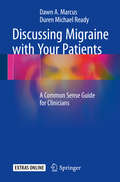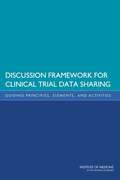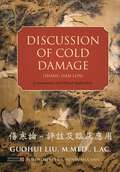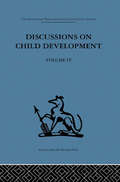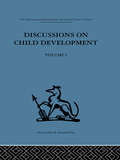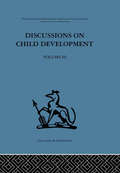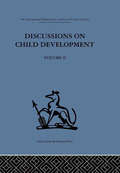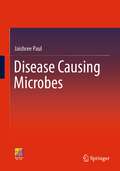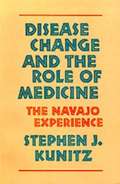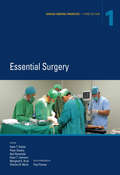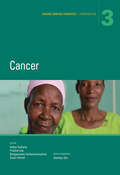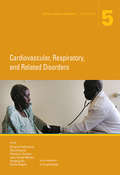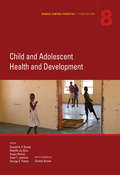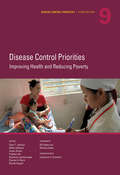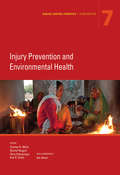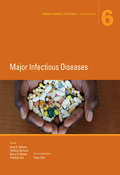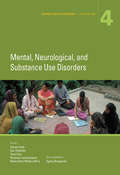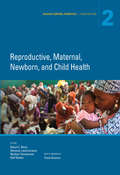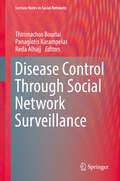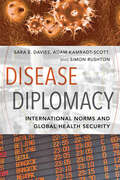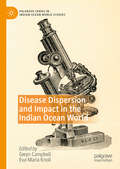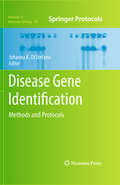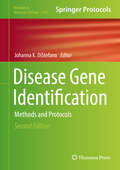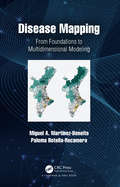- Table View
- List View
Discussing Migraine With Your Patients
by Dawn A. Marcus Duren Michael ReadyThis engaging and highly practical title is designed to support healthcare professionals in providing the best possible care for their patients with migraine. Developed by two leading authorities in the field who bring wit and warmth to their writing, the book combines the valuable wisdom of their clinical expertise with cutting edge scientific synthesis and helpful clinical pearls. Replete with a plethora of instructional aids and clinical tools (such as patient handouts, questionnaires, checklists, video clips, and quick-reference boxes), Discussing Migraine with Your Patients: A Common Sense Guide for Clinicians reviews migraine treatment in an evidence-based manner -- according to the empirical data and FDA and consensus-based guidelines. Discussion topics include acute and preventive pharmacotherapy, medical interventions and devices, behavioral and psychological nonpharmacologic therapies, education, trigger management, healthy lifestyle practices, stress management, neutraceuticals, and alternative medicine offerings. In addition, this easy-to-read title covers genetics and pathophysiology, symptoms and comorbidities, and a range of essential clinical skills that are useful in achieving the best possible outcomes with patients. In invaluable addition to the literature, this title will serve as the ultimate go-to resource for primary care clinicians and trainees. Headache specialists, too, will find value in this work.
Discussion Framework for Clinical Trial Data Sharing
by Institute of Medicine Board on Health Sciences Policy Committee on Strategies for Responsible Sharing of Clinical Trial DataSharing data generated through the conduct of clinical trials offers the promise of placing evidence about the safety and efficacy of therapies and clinical interventions on a firmer basis and enhancing the benefits of clinical trials. Ultimately, such data sharing - if carried out appropriately - could lead to improved clinical care and greater public trust in clinical research and health care. Discussion Framework for Clinical Trial Data Sharing: Guiding Principles, Elements, and Activities is part of a study of how data from clinical trials might best be shared. This document is designed as a framework for discussion and public comment. This framework is being released to stimulate reactions and comments from stakeholders and the public. The framework summarizes the committee's initial thoughts on guiding principles that underpin responsible sharing of clinical trial data, defines key elements of clinical trial data and data sharing, and describes a selected set of clinical trial data sharing activities.
Discussion of Cold Damage (Shang Han Lun): Commentaries and Clinical Applications
by Henry Mccann Guohui LiuA major new translation of the Chinese classic Shang Han Lun by scholar and medical doctor Guohui Liu makes this foundational text fully accessible to English speaking clinicians for the first time. Extensive study and research underpins the translation; the author's understanding of both classical and modern Chinese enables him to interpret fully the ancient work within the theory of Chinese medicine. An extensive commentary explains the translation, the difficulties with the text, how it has been subsequently translated and expands on the theory laid out in the original text to reach an understanding that can be applied in the clinic for diagnosis and treatment. The value of this classic text lies primarily in its establishment of a basic framework for differentiation and treatment, but it also presents 112 formulas and 88 medicinal substances, which are commonly applied in clinical work for various conditions. In this edition, the 112 formulas are fully explained in the context of the clinical experiences of well-known ancient and modern doctors, and they are also laid out in two appendices, cross referenced to the text.
Discussions on Child Development: Volume four
by Bärbel Inhelder J. M. TannerTavistock Press was established as a co-operative venture between the Tavistock Institute and Routledge & Kegan Paul (RKP) in the 1950s to produce a series of major contributions across the social sciences. This volume is part of a 2001 reissue of a selection of those important works which have since gone out of print, or are difficult to locate. Published by Routledge, 112 volumes in total are being brought together under the name The International Behavioural and Social Sciences Library: Classics from the Tavistock Press. Reproduced here in facsimile, this volume was originally published in 1960 and is available individually. The collection is also available in a number of themed mini-sets of between 5 and 13 volumes, or as a complete collection.
Discussions on Child Development: Volume one
by J M Tanner Bärbel InhelderTavistock Press was established as a co-operative venture between the Tavistock Institute and Routledge & Kegan Paul (RKP) in the 1950s to produce a series of major contributions across the social sciences. This volume is part of a 2001 reissue of a selection of those important works which have since gone out of print, or are difficult to locate. Published by Routledge, 112 volumes in total are being brought together under the name The International Behavioural and Social Sciences Library: Classics from the Tavistock Press. Reproduced here in facsimile, this volume was originally published in 1956 and is available individually. The collection is also available in a number of themed mini-sets of between 5 and 13 volumes, or as a complete collection.
Discussions on Child Development: Volume three
by J M Tanner Bärbel InhelderTavistock Press was established as a co-operative venture between the Tavistock Institute and Routledge & Kegan Paul (RKP) in the 1950s to produce a series of major contributions across the social sciences. This volume is part of a 2001 reissue of a selection of those important works which have since gone out of print, or are difficult to locate. Published by Routledge, 112 volumes in total are being brought together under the name The International Behavioural and Social Sciences Library: Classics from the Tavistock Press. Reproduced here in facsimile, this volume was originally published in 1958 and is available individually. The collection is also available in a number of themed mini-sets of between 5 and 13 volumes, or as a complete collection.
Discussions on Child Development: Volume two
by J M Tanner Bärbel InhelderTavistock Press was established as a co-operative venture between the Tavistock Institute and Routledge & Kegan Paul (RKP) in the 1950s to produce a series of major contributions across the social sciences. This volume is part of a 2001 reissue of a selection of those important works which have since gone out of print, or are difficult to locate. Published by Routledge, 112 volumes in total are being brought together under the name The International Behavioural and Social Sciences Library: Classics from the Tavistock Press. Reproduced here in facsimile, this volume was originally published in 1956 and is available individually. The collection is also available in a number of themed mini-sets of between 5 and 13 volumes, or as a complete collection.
Disease Causing Microbes
by Jaishree PaulThis book provides knowledge on the diversity of disease-causing microbes including bacteria, viruses, fungi and protozoans—the major diseases they cause and the environmental factors that influence the occurrence, transmission and spread of microbes along with the epidemiological factors determining the occurrence of disease. The book mainly covers a broad spectrum of diseases infecting different organs of human and describes the microorganisms involved in the process. The diseases caused by parasites and helminths are also included in the text since the infective stages of parasites as well as helminths are microscopic in nature and need to be distinguished from bacterial infections by appropriate diagnosis.
Disease Change and the Role of Medicine: The Navajo Experience
by Stephen J. Kunitz Charles M. LeslieStephen Kunitz's work raises crucial issues for public policy in the medical field, and will be valuable for social scientists, physicians, and health professionals concerned with the social context of public health and other medical facilities.
Disease Control Priorities, Third Edition (Volume #1)
by Atul Gawande Jamison Peter Donkor Haile T. Debas Margaret E. Kruk Charles N. MockAbout this Series: From its inception, the Disease Control Priorities series has focused attention on delivering efficacious health interventions that can result in dramatic reductions in mortality and disability at relatively modest cost. The approach has been multidisciplinary, and the recommendations have been evidence-based, scalable, and adaptable in multiple settings. Better and more equitable health care is the shared responsibility of governments and international agencies, public and private sectors, and societies and individuals, and all of these partners have been involved in the development of the series. Disease Control Priorities, third edition (DCP3) builds on the foundation and analyses of the first and second editions (DCP1 and DCP2) to further inform program design and resource allocation at the global and country levels by providing an up-to-date comprehensive review of the effectiveness of priority health interventions. In addition, DCP3 presents systematic and comparable economic evaluations of selected interventions, packages, delivery platforms, and policies based on newly developed economic methods. DCP3 presents its findings in nine individual volumes addressed to specific audiences. The volumes are structured around packages of conceptually related interventions, including those for maternal and child health, cardiovascular disease, infectious disease, and surgery. The volumes of DCP3 will constitute an essential resource for countries as they consider how best to improve health care, as well as for the global health policy community, technical specialists, and students. About this Volume: Essential Surgery demonstrates surgery's contribution to global public health. Data on the surgical burden of congenital anomalies, disease, disability, and trauma are presented, along with health and economic analyses of procedures, platforms, and packages to improve care in settings with severe budget limitations. Readers will gain comprehensive knowledge of the challenges and successes found in implementing surgical care strategies within low- and middle-income countries. Practitioners and researchers demonstrate that even small hospitals can deliver effective basic surgical services, and health care delivery structures already in place can be leveraged to provide affordable and quality surgical care.
Disease Control Priorities, Third Edition (Volume #3)
by Hellen Gelband Horton Rengaswamy Sankaranarayanan Prabhat JhaVolume 3, Cancer, presents the complex patterns of cancer incidence and death around the world and evidence on effective and cost-effective ways to control cancers. The DCP3 evaluation of cancer will indicate where cancer treatment is ineffective and wasteful, and offer alternative cancer care packages that are cost-effective and suited to low-resource settings. Main messages from the volume include: -Quality matters in all aspects of cancer treatment and palliation. -Cancer registries that track incidence, mortality, and survival " paired with systems to capture causes of death are important to understanding the national cancer burden and the effect of interventions over time. -Effective interventions exist at a range of prices. Adopting "resource appropriate" measures which allow the most effective treatment for the greatest number of people will be advantageous to countries. -Prioritizing resources toward early stage and curable cancers is likely to have the greatest health impact in low income settings. -Research prioritization is no longer just a global responsibility. Providing cancer treatment requires adequate numbers of trained healthcare professionals and infrastructure beyond what is available in most LMICs, especially low income countries. Careful patient monitoring is a requirement of good quality cancer care and this often involves laboratory tests in addition to clinical examination. Even if financing were immediately available to build or expand a cancer control system, reaching capacity will take many years.
Disease Control Priorities, Third Edition: Cardiovascular, Respiratory, and Related Disorders (Volume #5)
by Rachel Nugent Dorairaj Prabhakaran Shuchi Anand Thomas A. Gaziano MbanyaCardiovascular, respiratory, and related conditions cause more than 40 percent of all deaths globally, and their substantial burden is rising, particularly in low- and middle-income countries (LMICs). Their burden extends well beyond health effects to include significant economic and societal consequences. Most of these conditions are related, share risk factors, and have common control measures at the clinical, population, and policy levels. Lives can be extended and improved when these diseases are prevented, detected, and managed. This volume summarizes current knowledge and presents evidence-based interventions that are effective, cost-effective, and scalable in LMICs.
Disease Control Priorities, Third Edition: Child and Adolescent Health and Development (Volume #8)
by Jamison Susan Horton Donald A. Bundy Nilanthi De SilvaMore children born today will survive to adulthood than at any time in history. It is now time to emphasize health and development in middle childhood and adolescence--developmental phases that are critical to health in adulthood and the next generation. Child and Adolescent Health and Development explores the benefits that accrue from sustained and targeted interventions across the first two decades of life. The volume outlines the investment case for effective, costed, and scalable interventions for low-resource settings, emphasizing the cross-sectoral role of education. This evidence base can guide policy makers in prioritizing actions to promote survival, health, cognition, and physical growth throughout childhood and adolescence.
Disease Control Priorities, Third Edition: Improving Health and Reducing Poverty (Volume #9)
by Susan Horton Hellen Gelband Charles N. Mock Rachel Nugent Jha Dean T. JamisonAs the culminating volume in the DCP3 series, volume 9 will provide an overview of DCP3 findings and methods, a summary of messages and substantive lessons to be taken from DCP3, and a further discussion of cross-cutting and synthesizing topics across the first eight volumes. The introductory chapters (1-3) in this volume take as their starting point the elements of the Essential Packages presented in the overview chapters of each volume. First, the chapter on intersectoral policy priorities for health includes fiscal and intersectoral policies and assembles a subset of the population policies and applies strict criteria for a low-income setting in order to propose a "highest-priority" essential package. Second, the chapter on packages of care and delivery platforms for universal health coverage (UHC) includes health sector interventions, primarily clinical and public health services, and uses the same approach to propose a highest priority package of interventions and policies that meet similar criteria, provides cost estimates, and describes a pathway to UHC.
Disease Control Priorities, Third Edition: Injury Prevention and Environmental Health (Volume #7)
by Smith Charles N. Mock Rachel Nugent Olive KobusingyeThe substantial burden of death and disability that results from interpersonal violence, road traffic injuries, unintentional injuries, occupational health risks, air pollution, climate change, and inadequate water and sanitation falls disproportionally on low- and middle-income countries. Injury Prevention and Environmental Health addresses the risk factors and presents updated data on the burden, as well as economic analyses of platforms and packages for delivering cost-effective and feasible interventions in these settings. The volume's contributors demonstrate that implementation of a range of prevention strategies-presented in an essential package of interventions and policies-could achieve a convergence in death and disability rates that would avert more than 7.5 million deaths a year.
Disease Control Priorities, Third Edition: Major Infectious Diseases (Volume #6)
by King K. Holmes Stefano Bertozzi Barry R. Bloom JhaInfectious diseases are the leading cause of death globally, particularly among children and young adults. The spread of new pathogens and the threat of antimicrobial resistance pose particular challenges in combating these diseases. Major Infectious Diseases identifies feasible, cost-effective packages of interventions and strategies across delivery platforms to prevent and treat HIV/AIDS, other sexually transmitted infections, tuberculosis, malaria, adult febrile illness, viral hepatitis, and neglected tropical diseases. The volume emphasizes the need to effectively address emerging antimicrobial resistance, strengthen health systems, and increase access to care. The attainable goals are to reduce incidence, develop innovative approaches, and optimize existing tools in resource-constrained settings.
Disease Control Priorities, Third Edition: Mental, Neurological, and Substance Use Disorders (Volume #4)
by Vikram PatelMental, neurological, and substance use disorders are common, highly disabling, and associated with significant premature mortality. The impact of these disorders on the social and economic well-being of individuals, families, and societies is large, growing, and underestimated. Despite this burden, these disorders have been systematically neglected, particularly in low- and middle-income countries, with pitifully small contributions to scaling up cost-effective prevention and treatment strategies. Systematically compiling the substantial existing knowledge to address this inequity is the central goal of this volume. This evidence-base can help policy makers in resource-constrained settings as they prioritize programs and interventions to address these disorders.
Disease Control Priorities, Third Edition: Reproductive, Maternal, Newborn, and Child Health (Volume #2)
by Walker Robert Black Marleen Temmerman Ramanan LaxminarayanThe evaluation of reproductive, maternal, newborn, and child health (RMNCH) by the Disease Control Priorities, Third Edition (DCP3) focuses on maternal conditions, childhood illness, and malnutrition. Specifically, the chapters address acute illness and undernutrition in children, principally under age 5. It also covers maternal mortality, morbidity, stillbirth, and influences to pregnancy and pre-pregnancy. Volume 3 focuses on developments since the publication of DCP2 and will also include the transition to older childhood, in particular, the overlap and commonality with the child development volume. The DCP3 evaluation of these conditions produced three key findings: 1. There is significant difficulty in measuring the burden of key conditions such as unintended pregnancy, unsafe abortion, nonsexually transmitted infections, infertility, and violence against women. 2. Investments in the continuum of care can have significant returns for improved and equitable access, health, poverty, and health systems. 3. There is a large difference in how RMNCH conditions affect different income groups; investments in RMNCH can lessen the disparity in terms of both health and financial risk.
Disease Control Through Social Network Surveillance (Lecture Notes in Social Networks)
by Panagiotis Karampelas Thirimachos Bourlai Reda AlhajjThis book examines modern paradigms of disease control based on social network surveillance applications, including electronic sentinel surveillance and wireless application-based surveillance science. It also highlights topics that integrate statistical and epidemiological sciences with surveillance practice and, in order to reflect the evolution of social networking practices, discusses topics concerning the challenges for surveillance theory and practice. In turn, the book goes a step further by providing insights on how we need to analyse epidemiological trends by following best practices on distinguishing useful information from noise, namely fake news, false reporting of disease incidents and events, etc. At the same time, we need to be able to protect health-focused applications and communication tools via cybersecurity technologies and to ensure that anonymity of reporting and privacy are preserved. In closing, the book discusses the role and impact of social media on disease surveillance, as well as the current role of communities in infectious disease surveillance and control.
Disease Diplomacy: International Norms and Global Health Security
by Simon Rushton Adam Kamradt-Scott Sara E. DaviesHave the revised International Health Regulations allowed states to rise to the challenge of delivering global health security?In the age of air travel and globalized trade, pathogens that once took months or even years to spread beyond their regions of origin can now circumnavigate the globe in a matter of hours. Amid growing concerns about such epidemics as Ebola, SARS, MERS, and H1N1, disease diplomacy has emerged as a key foreign and security policy concern as countries work to collectively strengthen the global systems of disease surveillance and control. The revision of the International Health Regulations (IHR), eventually adopted by the World Health Organization’s member states in 2005, was the foremost manifestation of this novel diplomacy. The new regulations heralded a profound shift in international norms surrounding global health security, significantly expanding what is expected of states in the face of public health emergencies and requiring them to improve their capacity to detect and contain outbreaks. Drawing on Martha Finnemore and Kathryn Sikkink’s "norm life cycle" framework and based on extensive documentary analysis and key informant interviews, Disease Diplomacy traces the emergence of these new norms of global health security, the extent to which they have been internalized by states, and the political and technical constraints governments confront in attempting to comply with their new international obligations. The authors also examine in detail the background, drafting, adoption, and implementation of the IHR while arguing that the very existence of these regulations reveals an important new understanding: that infectious disease outbreaks and their management are critical to national and international security.The book will be of great interest to academic researchers, postgraduate students, and advanced undergraduates in the fields of global public health, international relations, and public policy, as well as health professionals, diplomats, and practitioners with a professional interest in global health security.
Disease Dispersion and Impact in the Indian Ocean World (Palgrave Series in Indian Ocean World Studies)
by Gwyn Campbell Eva-Maria KnollThis volume views the study of disease as essential to understanding the key historical developments underpinning the foundation of contemporary Indian Ocean World (IOW) societies. The interplay between disease and climatic conditions, natural and manmade crises and disasters, human migration and trade in the IOW reveals a wide range of perceptions about disease etiologies and epidemiologies, and debates over the origin, dispersion and impact of disease form a central focus in these essays. Incorporating a wide scope of academic and scientific angles including history, social and medical anthropology, archaeology, epidemiology and paleopathology, this collection focuses on diseases that spread across time, space and cultures. It scrutinizes disease as an object, and engages with the subjectivities of afflicted inhabitants of, and travellers to, the IOW.
Disease Gene Identification
by Johanna K. DistefanoRecent efforts to characterize genetic variation in the human genome, coupled with the rapidly developing field of genomics, have lead directly to the development of new and innovative approaches to the identification of genes contributing to complex human diseases. In Disease Gene Identification: Methods and Protocols, expert researchers in the field provide up-to-date molecular methodologies used in the process of identifying a disease gene, from the initial stage of study design to the next stage of preliminary locus identification, and ending with stages involved in target characterization and validation. As a volume in the highly successful Methods in Molecular BiologyTM series, chapters contain brief introductions to their respective topics, lists of the necessary materials and reagents, step-by-step, readily reproducible laboratory protocols, and detailed tips on troubleshooting and avoiding known pitfalls. Authoritative and essential, Disease Gene Identification: Methods and Protocols seeks to aid scientists striving toward the identification and characterization of the many disease-related genes, which may someday pave the way for more accurate and improved methods of disease diagnosis as well as vital strategies for disease treatment and prevention.
Disease Gene Identification: Methods and Protocols (Methods in Molecular Biology #1706)
by Johanna K. DiStefanoThis volume presents detailed laboratory procedures in an easy to follow format that can be carried out with success by investigators lacking previous exposure to a specific research method. Chapter guide readers through the application of molecular approaches to disease gene identification and overviews, and case studies are also presented. Written in the highly successful Methods in Molecular Biology series format, chapters include introductions to their respective topics, lists of the necessary materials and reagents, step-by-step, readily reproducible laboratory protocols, and tips on troubleshooting and avoiding known pitfalls.Authoritative and practical, Disease Gene Identification: Methods and Protocols, Second Edition aims to help with the identification and characterization of many more disease-related genes and provide novel, and effective strategies for disease treatment and prevention.
Disease Handbook for Massage Therapists
by Ruth WernerDisease Handbook for Massage Therapists is a quick reference for practicing massage therapists who need to make on-the-spot decisions on the applicability of their work when pathologies are present. The book covers a variety of conditions, listed alphabetically, and presents the following information on each condition: a brief definition and description, with associated diseases indicated in bold; a list of signs and symptoms; a description of common treatment options, particularly those that might influence choices about massage; a list of frequently recommended medications, which can be further explored in Drug Handbook for Massage Therapists; and a discussion of massage considerations, including risks, benefits, and advice for practitioners.
Disease Mapping: From Foundations to Multidimensional Modeling
by Miguel A. Martinez-Beneito Paloma Botella-RocamoraDisease Mapping: From Foundations to Multidimensional Modeling guides the reader from the basics of disease mapping to the most advanced topics in this field. A multidimensional framework is offered that makes possible the joint modeling of several risks patterns corresponding to combinations of several factors, including age group, time period, disease, etc. Although theory will be covered, the applied component will be equally as important with lots of practical examples offered. Features: Discusses the very latest developments on multivariate and multidimensional mapping. Gives a single state-of-the-art framework that unifies most of the previously proposed disease mapping approaches. Balances epidemiological and statistical points-of-view. Requires no previous knowledge of disease mapping. Includes practical sessions at the end of each chapter with WinBUGs/INLA and real world datasets. Supplies R code for the examples in the book so that they can be reproduced by the reader. About the Authors: Miguel A. Martinez Beneito has spent his whole career working as a statistician for public health services, first at the epidemiology unit of the Valencia (Spain) regional health administration and later as a researcher at the public health division of FISABIO, a regional bio-sanitary research center. He has been also the Bayesian Hierarchical Models professor for several seasons at the University of Valencia Biostatics Master. Paloma Botella Rocamora has spent most of her professional career in academia although she now works as a statistician for the epidemiology unit of the Valencia regional health administration. Most of her research has been devoted to developing and applying disease mapping models to real data, although her work as a statistician in an epidemiology unit makes her develop and apply statistical methods to health data, in general.
